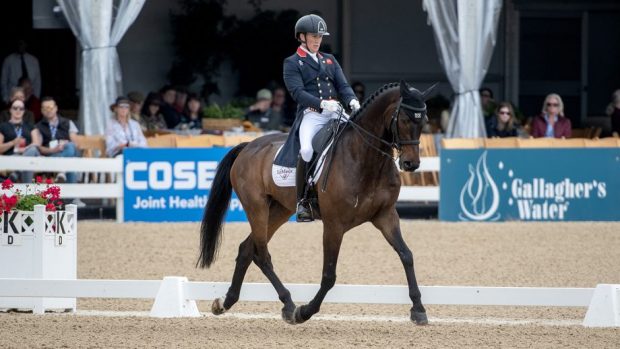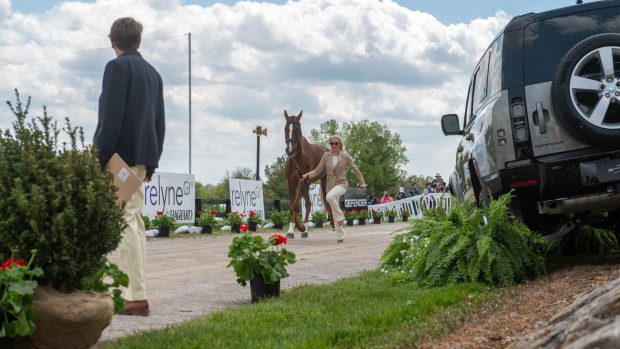1. How should I put my horse into a vehicle safel?
The groom should stand in front of the horse and hold him with both hands. Never back the horse into the vehicle, as he could tread on a shaft or collide with it if he does not backstraight. The vehicle should be pulled forward to the horse, preferably with a person holding each shaft and speaking to the horse while putting the shafts into the tugs, up to the stop s.
The traces and then the breeching should be attached before adjusting the false belly band. Check that everything is correctly adjusted before mounting the vehicle.
The driver then takes the reins in his left hand before mounting the vehicle on the near side. He must get seated as quickly and quietly as possible, taking up his whip in his right hand.
When dismounting, the groom gets out of the vehicle first and stands in front of the horse while the passengers dismount. The driver always leaves the vehicle last. He leaves the whip in the whip socket and dismounts with the reins in his hand before putting them into the terrets.
The groom remains holding the horse when it is taken out of the vehicle. Firstly, unfasten both breechings and then each trace before loosening the false belly band. Never loosen this completely, as a two-wheeled vehicle can tip up.
Carefully push the shafts out of the tugs and move the vehicle away from the horse. Never pull the horse forward while he is still attached to the vehicle, as a piece of harness could become caught and cause an accident.
2. How much schooling should I do at home before going to a show?
However much schooling you have done at home, until your horse is used to a show atmosphere, he will not settle and listen to you.
At your first show, you should not necessarily enter a competition.
Instead, drive round the car parks, where your horses can listen to the loud speakers and bands away from the crowds. It is impossible to emulate these experiences anywhere else, so your best solution is to go and find them.
At home always remember to practice with your show harness because if your horses are not used to it, this adds another unknown dimension to driving in a strange environment.
Always buy good quality leather and look after it well. Check all the stitching every time you clean it and have any necessary repairs carried out immediately.
If there are any serious problems with the horses, sort these out from the saddle or on long-reins. The emphasis should always be on manners and steadiness, while aiming to have the horse going forward and concentrating.
Most schooling in harness is carried out at working trot, because if one aims for too much collection, the horse will lose his impulsion.At a show, some drivers forget to use their voice and usual expressions, which are a vital schooling aid.
During a driving dressage test, unlike under saddle, you are allowed to use your voice and should do so.
3. My horses are not keen to go backwards in harness. How can I teach them?
Before attempting to ask horses to move back in harness, they should have been taught from the ground on long-reins. They should be trained from the voice, which can only be achieved if they have been correctly schooled. If you only obtain one small step the first time, praise the horse and do not ask again.
If the horse is unwilling to back, try asking him on long-reins or when wearing an open bridle (without blinkers) to gain his confidence. Once the horse reverses on command and from gentle pressure on the reins, ask him when wearing blinkers before attempting it in harness.
We ask novice horses to go backwards every time they go out, beginning on a natural incline. When they reach a more advanced stage, move the vehicle onto level ground.
If a horse is difficult,it can help to have someone standing on the ground in front of him, encouraging him to go backwards by pushing the shoulder.
Every time you ask the horse to go backwards, use the same verbal command so that eventually he will begin moving before a physical aid is given.
Before a horse can back, either in harness or under saddle, his head must be in the correct position and not sticking up in the air. If necessary, use draw reins – either when long-reining or when riding ¨ to encourage the horse to flex his poll and adopt a outline from where he will find it easy to move backwards.
4. How will the different surfaces I may meet on a marathon effect the way I drive?
You should practice driving on as many different surfaces as possible. Crossing gravel or other stony surfaces for the first time may worry a horse because of the unaccustomed noise.
You will often meet boards placed over cattle grids in a marathon and to start with, the driver should have a good contact on the reins and be prepared to encourage his horse with the whip, if necessary.
When driving, you should always be thinking ahead and be aware of the next surface you are coming to. For example, when moving from a road onto grass, the driver should collect the horses up and move at a steadier pace.
When driving over uneven surfaces, ensure that the horses are more collected so that they cannot suddenly increase speed, which leads to the driver losing control.
If this does happen, try to pull the horses back as quickly as possible and then aim for the nearest hedge or wall. Never attempt to turn at a gallop, as the vehicle will tip over.
Under no circumstances should anyone drive alone. If the vehicle does tip over, the driver never lets go of the reins or gets out of the vehicle until the horse has been caught by someone. He sends the groom out to sort out the problem.
The groom’s first job is to get hold of the horse’s head and quietly unhitch him, cutting any leather if necessary. Because of this, he should always carry a sharp knife.
Once the horse is free, he should be put back in harness that day, even if it is in another vehicle. Horses have very good memories, so it is unadvisable to leave an unpleasant incident in the front of their minds.



